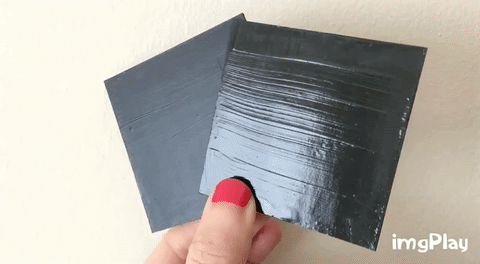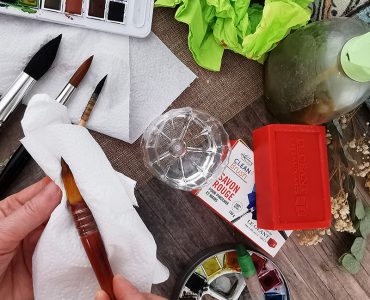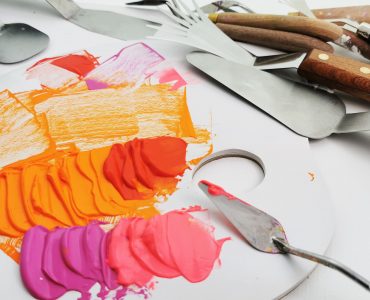Amylee shows just how easy it is to adjust your finish!
Varnishing gives a beautiful and durable finish, but what do you do if you want to reduce gloss? Here’s a useful guide presented by Amylee Paris to show you how to change the appearance of varnish and maintain your painting at its best.
An easy way to change the varnish on an acrylic painting
You’ve just applied a coat of glossy varnish on an acrylic painting, and the drying result does not really suit you? Light reflections make you uncomfortable? You’re thinking about using a matt varnish? Don’t panic, this article will help you to see more clearly!
Recently, I got the idea to combine 3 acrylic varnishes: glossy, satin, and matt to note the effects obtained and see if it was possible to change the brightness of a varnish which has already been applied and allowed to dry, by adding a new one.
〉Varnish on Acrylic Painting:
I always apply a layer of varnish on my acrylic paintings. Acrylic paint is a tough plastic resin, however it is made up of micro perforations (invisible to naked eye) that allow residues and water to clog colours. The varnish will clog the porous parts, providing optimal preservation.
〉 Do you want to change the varnish on an acrylic painting?
Unlike Decorating where it is necessary to sand and strip objects (furniture, doors, and so on) before applying a different coat of varnish, for artist’s paintings, it is better not to be too rough. If the varnish is old, dirty or damaged, it can be removed with a specific cleaner. The technique is a quite delicate process, so if you have never done this, I suggest you contact a professional restorer to avoid disappointing results which may damage the painting under the varnish.
If the varnish has been recently applied or it looks clean, you can simply change it by laying a second layer of varnish over it. I explain all of this below:
〉Great to know with varnishing:
- Use wide flat brushes or spalters with fine, soft and supple fibres.
- The varnish surface and your tools have to be clean and dry.
- To minimize running, work horizontally with the painting laid flat on a table (especially with liquid varnish) and sufficient drying time in between.
- Apply 2 or more thin layers of varnish depending on the absorption of the artwork and the desired effect.
- Work in a dry room, with no drafts, dust, or other loose particles like hair.
〉3 different varnishes:
Here I use the LASCAUX VARNISH in 250ml bottles. I use this regularly for all my paintings and am very satisfied with the results. It is a water-based acrylic polymer, translucent and milky with a subtle odour, which becomes fully transparent and water-resistant after a fast drying time. This varnis is available in:
- Matt Transparent 2-UV 2063
- Satin Transparent 3-UV 2065
- Glossy Transparent 1-UV 2062
 From the left: matt varnish – satin varnish – glossy varnish
From the left: matt varnish – satin varnish – glossy varnish
Notice: After use, clean all equipment immediately with Artists soap.
Léonard Black soap (bar or bottle)
Find all these products at GreatArt Online or in their art supply shop in London Shoreditch.
〉Testing Varnishes:
For this test, I use square cardboard samples covered with black acrylic paint (I LOVE ART). I cover some of them with a single coat of varnish and others I add a second different varnish to note my results:
〉TEST #1 : Glossy on Matt
- The two samples just below were coated with a single layer of matt varnish.
- On the right sample I added on the top one layer of glossy varnish.

- Right sample RESULTS : Glossy on Matt = Glossy
〉TEST #2 : Matt on Glossy
- The two samples just below were coated with a single layer of glossy varnish.
- On the right sample I added on the top one layer of matt varnish.

- Right sample RESULTS : Matt on Glossy = Matt
Notice: Satin varnish gives the same results as glossy varnish. I also find (in this Lascaux range) that the satin varnish is a little too bright especially if applied generously. To soften its shine, I usually mix it with matt varnish.
〉CONCLUSION about my testing:
With this small experiment, we can observe that it is the top varnish also called “final varnish” which gives the definitive shine to an acrylic painting.You can cover a varnish, (if it does not suit us, and providing it is clean and undamaged) with another one more or less shiny.
〉Amylee’s review:
- MATT VARNISH tends to extinguish colours, especially blacks. The milky veil seems to cover and age colours, which can sometimes give a faded effect to the composition.
- GLOSSY VARNISH makes colours saturated and blacks deeper. It is also a good trick for giving acrylic the appearance of oil. You should avoid to use glossy varnish on large monochromatic flat surfaces because it brings out all the dust. The shiny effects are not to the taste of everyone but it is nevertheless my favourite varnish.
Glossy, matt or satin, make your choice!
Information for this article was provided by professional fine artist, Amylee Paris. You can visit her colourful portfolio or follow her on Facebook and Instagram.
Find all Amylee’s posts published in GreatArt online Magazine by clicking here!
GreatArt – your art superstore
Art supplies, ideas and advice for all techniques.
GreatArt offers you art supplies for all techniques from:
- traditional fine art painting,
- drawing,
- sculpture,
- printmaking,
- graphic art,
- illustration,
- airbrushing,
- model making…
We offer an extensive range of stretched canvas and display products for exhibition, all the art supplies required to create your own bespoke canvases, as well as custom framing and mounting services from GreatArt Store. You’ll also find hundreds of articles and tutorials to browse in the online magazine.





















Add comment